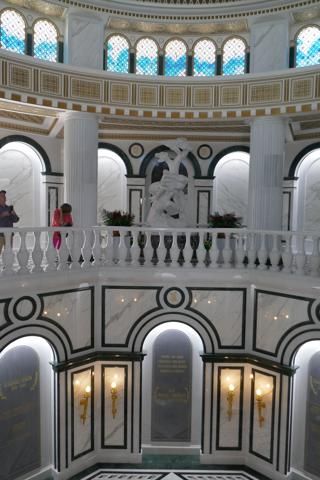Central Asia - Turkmenistan - Ashgabat - Part 2

Carpets hold such prominence in Turkmenistan that there is a Ministry of Carpet and a carpet is included on the national flag.
I missed the visit to the National Carpet Museum which displays more than 1,000 carpets, however I did get to the bazaar, a joy to see so many wonderful carpets. Below, the map of the bazaar is designed like a carpet, Bava, our guide demonstrates how felt carpets are made and the lady with the white head covering is serving tea from her cart, gossiping with traders.

There isn't much in the way of cafes or stand alone restaurants, so for our lunches and dinners, we’d visit one of the huge shopping centres and dine at a restaurant located within the food court. As you can see below, there were locals around, who looked to be middle class and it seemed dining out was reserved for special occasions. Lots of high-end shops but rarely with a customer.
Supervised play areas close by gave the children lots to do, giving adults a chance to relax with friends and family.

Despite the lack of communication with the outside world we were served the best food in Central Asia - English menus, great service, elegantly set tables with tablecloths, good china and very comfortable chairs.
It’s a Muslim country so we couldn’t miss the mosque, which towers over the flat landscape a little way out of town, close to the first President’s home village.

It's no surprise we are told the Gypjak Mosque is the largest mosque in Central Asia, completed in 2006 with space for 10,000 worshippers. Again white and gold, used only on special occasions. It's also known as the Turkmenbashi Mosque - as the first president commissioned the project and funded 80% of the costs. In the post yesterday, Drew visits the mosque in his video.
Next door to the mosque is the Presidential Mausoleum and equally beautiful as you can see below. The first president of Turkmenistan and his family are buried together.



Turkmen are very proud of their horses - the breed Akhalteke thought to be the rootstock of Arabian thoroughbreds. Attending horse races is free and the locals are mad about cheering on their favourite horse, however there is no betting - as you’d expect in Turkmenistan - it’s illegal. No race meetings were scheduled during our visit, but content visiting a stable and admiring some very fine horses.

Several of our group left on a 2 day extension to see the Darvaza Gas Crater. It’s a long drive on a very bad road, not something I’d enjoy, but the crater looked interesting.
The Darvaza Gas Crater was formed in the early 1970s, when the ground collapsed during a Soviet gas drilling expedition. Scientists reportedly lit the massive hole to prevent the spread of natural gas, and it's been burning ever since.
It was time to leave the incredible but weird city of Ashgabat, flying to our next destination.
A final architectural delight was the elegant airport building - appropriately the design reflects a falcon in flight. The ceiling inside equally stunning.
Only our aircraft was sitting on the runway. The flight was full but still check-in and boarding was a breeze. Other than Turkmenistan Airlines, there are few airlines allowed into the country - Aeroflot and Turkish airlines, perhaps Emirates or Qatar soon.
It gave me a laugh to see the gate numbers all started with 300 or 400 - but there’s actually only a handful of gate lounges.

We flew into Ashgabat from Mary visiting Merv in the south, flying out again to Dashoguz visiting Koneurgench, in the north of Turkmenistan.
Following on tomorrow - two very different parts of Turkmenistan.
